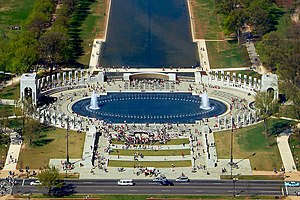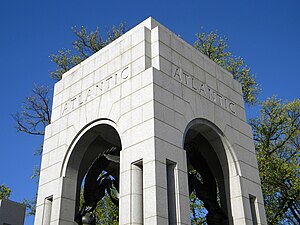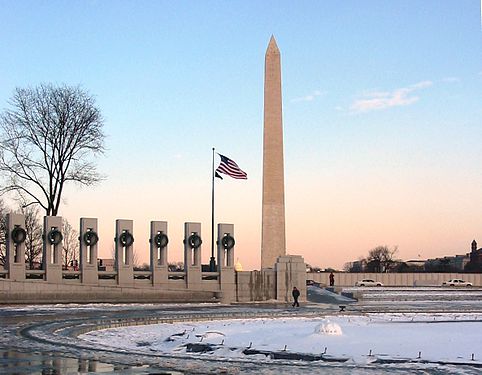
The Lincoln Memorial Reflecting Pool is the largest of the many reflecting pools in Washington, D.C.. It is a 2,030-by-167-foot rectangular pool located on the National Mall, directly east of the Lincoln Memorial, with the World War II Memorial and Washington Monument to the east of the reflecting pool.
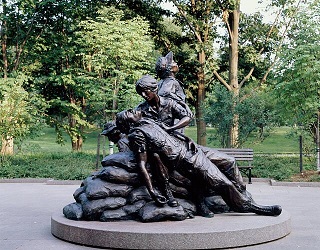
The Vietnam Women's Memorial is a memorial dedicated to the nurses and women of the United States who served in the Vietnam War. It depicts three uniformed women with a wounded male soldier to symbolize the support and caregiving roles that women played in the war as nurses and other specialists. It is part of the Vietnam Veterans Memorial and is located on the National Mall in Washington, D.C., a short distance south of the Wall and north of the Reflecting Pool. The statues are bronze and the base is made of granite. The United States Commission of Fine Arts and the National Capital Planning Commission selected Glenna Goodacre to sculpt the memorial after previously rejecting the idea for a memorial to women.

The Normandy American Cemetery and Memorial is a World War II cemetery and memorial in Colleville-sur-Mer, Normandy, France, that honors American troops who died in Europe during World War II. It is located on the site of the former temporary battlefield cemetery of Saint Laurent, covers 172.5 acres and contains 9,388 burials.

The American Battle Monuments Commission (ABMC) is an independent agency of the United States government that administers, operates, and maintains permanent U.S. military cemeteries, memorials and monuments primarily outside the United States.

The National WWII Museum, formerly known as The NationalD-Day Museum, is a military history museum located in the Central Business District of New Orleans, Louisiana, U.S., on Andrew Higgins Drive between Camp Street and Magazine Street. The museum focuses on the contribution made by the United States to Allied victory in World War II. Founded in 2000, it was later designated by the U.S. Congress as America's official National WWII Museum in 2004. The museum is a Smithsonian Institution affiliated museum, as part of the Smithsonian Institution's outreach program. The mission statement of the museum emphasizes the American experience in World War II.

Littlefield Fountain is a World War I memorial monument designed by Italian-born sculptor Pompeo Coppini on the main campus of the University of Texas at Austin in Austin, Texas, at the entrance to the university's South Mall. Completed in 1933, the monument is named after university regent and benefactor George W. Littlefield, whose donation paid for its design and construction.

The Peace Monument, also known as the Navy Monument, Naval Monument or Navl-Peace Monument, stands on the western edge of the United States Capitol Complex in Washington, D.C. It is in the middle of Peace Circle, where First Street and Pennsylvania Avenue NW intersect. The surrounding area is Union Square, which the monument shares with the Ulysses S. Grant Memorial, James A. Garfield Monument, and the Capitol Reflecting Pool. The front of the monument faces west towards the National Mall while the east side faces the United States Capitol.

Cambridge American Cemetery and Memorial is a World War II American military war grave cemetery, lying between the villages of Coton and Madingley, 7 km (4.3 mi) north-west of Cambridge, England. The cemetery, dedicated in 1956, contains 3,811 American war dead and covers 30.5 acres (12.3 ha). It is one of 26 overseas military cemeteries administered by the American Battle Monuments Commission (ABMC).

The Japanese American Memorial to Patriotism During World War II is a National Park Service site to commemorate the contributions of American citizens of Japanese ancestry and their parents who patriotically supported the United States despite unjust treatment during World War II.

Ardennes American Cemetery and Memorial is a Second World War American military war grave cemetery, located in the village of Neuville-en-Condroz, near the southeast edge of Neupré, some 20 km (12 mi) south-west of Liège in Belgium. The cemetery, dedicated in 1960, contains 5,329 American war dead and covers 90.5 acres (36.6 ha). It is one of three American war cemeteries in Belgium, the other two being at Flanders Field and Henri-Chapelle and is administered by the American Battle Monuments Commission (ABMC).

The Polish Air Force Memorial is a war memorial in West London, England in memory of airmen from Poland who served in the Royal Air Force as part of the Polish contribution to World War II. Over 18,000 men and women served in the Polish squadrons of the RAF during the war, and over 2,000 died. The memorial marks the southern extremity of South Ruislip in the London Borough of Hillingdon, near RAF Northolt, where seven Polish-manned fighter squadrons were based at different times in the war.

Rhone American Cemetery and Memorial is a Second World War American military war grave cemetery, located within the city of Draguignan, 42 km (26 mi) north of Saint-Tropez, in Southern France. The cemetery, named for the Rhone river where most of those interred fought and died, was dedicated in 1956, and contains 858 American war dead and covers 12.5 acres (5.1 ha). It is administered by the American Battle Monuments Commission.
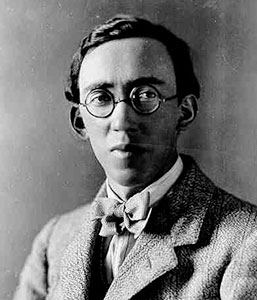
Vernon March (1891–1930) was an English sculptor, renowned for major monuments such as the National War Memorial of Canada in Ottawa, Ontario, the Samuel de Champlain Monument in Orillia, Ontario, and the Cape Town Cenotaph, South Africa. Without the benefit of a formal education in the arts, he was the youngest exhibitor at The Exhibition of the Royal Academy of Arts.
West Hartlepool War Memorial or Victory Square War Memorial or Victoria Square Cenotaph is a war memorial in Hartlepool, County Durham, England commemorating those from West Hartlepool who died in World War I and World War II. The war memorial, created in the 1920s, is located on Victoria Road in Hartlepool's Victory Square. The square was created for this monument.

Sicily–Rome American Cemetery and Memorial is a World War II American military war grave cemetery, located in Nettuno, near Anzio, Italy. The cemetery, containing 7,858 American war dead, covers 77 acres (31 ha) and was dedicated in 1956. It is administered by the American Battle Monuments Commission.

The Rainbow Pool was a reflecting pool located on the National Mall in Washington D.C., USA. It was designed by landscape architect Frederick Law Olmsted Jr., and was situated between the Lincoln Memorial Reflecting Pool, and 17th Street NW. The pool was renamed the Rainbow Pool on October 15, 1924, after it was noticed that its 124 nozzles created a "perfect rainbow" when turned on.

The American War Memorial is a World War I memorial in the British Overseas Territory of Gibraltar. It was built for the American Battle Monuments Commission in 1933, and incorporated into the main city wall, the Line Wall Curtain. It commemorated the successful alliance of the United States and the United Kingdom in their naval exploits in the vicinity of Gibraltar during the Great War. The monument was inaugurated in 1937. Sixty-one years later, in November 1998, the monument was the site of another unveiling ceremony, that of a bronze plaque which commemorated the World War II Allied invasion of North Africa, Operation Torch. That unveiling ceremony was one of a number of events that weekend whose guests included dignitaries from the United Kingdom and the United States.

The Royal Artillery Boer War Memorial is located on the south side of The Mall in Central London, close to the junction with Horse Guards Road at the northeast corner of St James's Park. Unveiled in 1910, it marks the deaths of the 1,083 soldiers of the Royal Artillery who died in the Second Boer War from 1899 to 1902 It has been a listed building since 1970.

The Texas World War II Memorial is an outdoor monument commemorating the more than 20,000 Texans who died in service during World War II, installed on the Texas State Capitol grounds in Austin, Texas, United States.

Washington, D.C., the capital of the United States, has a unique and diverse architectural history. Encompassing government, monumental, commercial, and residential buildings, D.C. is home to some of the country's most famous and popular structures designed by some of the leading architects of their time. The popularity of the city's buildings is reflected in the findings of a 2007 poll of Americans by the American Institute of Architects, which found that six of the top 10 most popular U.S. structures were located in Washington, D.C. Overall, the poll found, 17 of the top 150 most popular structures were located in the capital.
